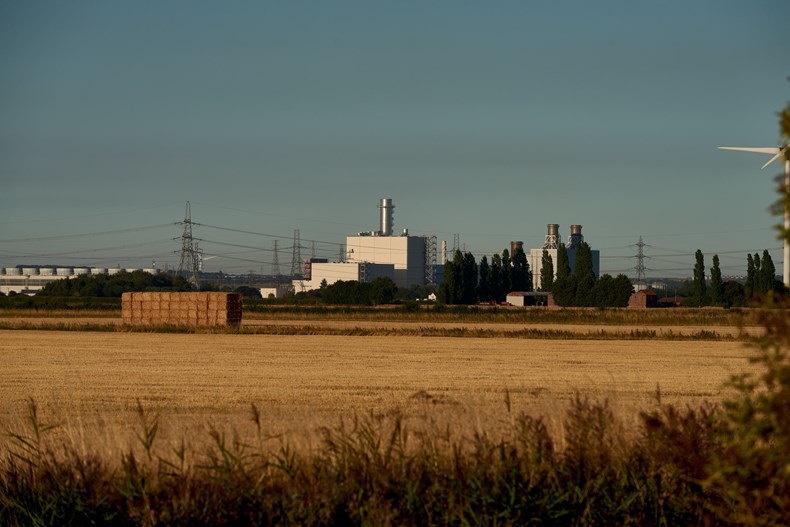
SSE and Equinor will consult on plans for a new hydrogen-fired power station in North Lincolnshire which would provide vital new reliable and flexible capacity to the electricity system.
Keadby Hydrogen Power Station is a proposed 900MW plant which could be operational from 2030 – bolstering security of supply and supporting the UK’s long-term decarbonisation by providing back-up low-carbon power to variable renewable generation.
The project will enter environmental scoping in April before SSE and Equinor launch a public consultation ahead of a full planning application being made in due course.
Under plans, the new power station will be designed to run on 100% hydrogen. The ambition is that this would be the case from inception, with Government already committed to deploying low-carbon infrastructure in the Humber – the UK’s most carbon intensive cluster.
Access to secure supplies of low-carbon hydrogen is essential to delivering a 100% hydrogen-fired power station. Hydrogen production, storage and transport infrastructure is required for a robust hydrogen system in the Humber and across the UK. Government is expected to select the first hydrogen transport and storage projects to progress over the next twelve months and has already delivered substantial support for hydrogen production projects, with SSE developing multiple projects across the value chain.
The need for new flexible power stations to be brought onto the system at the start of the 2030s has been outlined by UK Government through its consultation on the Review of Electricity Market Arrangements. In recognition of the capacity challenge, the planning application for Keadby Hydrogen would be ‘dual fuel’ in nature.
This means the plant has the capability to run on natural gas for an initial period if the necessary hydrogen infrastructure is not fully in place, while utilising market-leading turbine technology to ensure maximum efficiency. The station would then transition to running on low-carbon hydrogen as soon as practicable.
SSE’s Keadby site has a strategic role supporting the UK’s energy system. Formerly the site of a coal-fired power station, it now hosts Keadby 2 - one of the world’s most efficient gas-fired power stations - and England’s largest onshore wind farm. SSE and Equinor are also developing Keadby Carbon Capture Power Station, which is one of the only power CCS projects in the UK with planning permission but is also reliant on access to CO2 transport and storage infrastructure for progression.
The development of Keadby Hydrogen Power Station is consistent with SSE’s Net Zero Transition Plan which committed to the development and progression of new low-carbon flexible power including hydrogen-fuelled generation.
Martin Pibworth, Chief Commercial Officer of SSE, said:
"Delivering low-carbon flexible power is absolutely critical to the UK’s net zero efforts. We must also address the looming capacity challenge. The Government’s commitment to low-carbon technologies like hydrogen is clear but progress has been slower than hoped. As work continues on building policies and pipelines, we must simultaneously progress the development of new capacity that would help deliver on net zero while avoiding carbon lock-in for another generation – an approach we have seen in other European countries.
“At SSE, we know the UK’s energy future will be renewables-led, which is why we are building the world’s largest offshore wind farm at Dogger Bank. At the same time, the system needs flexible generation to provide back up when the wind doesn’t blow. As a company we are particularly well placed to deliver on the next generation of low-carbon power stations which will support both short-term and long-term energy needs.”
SSE’s net zero commitment
In March 2022, SSE published its Net Zero Transition Plan aiming to achieve net zero emissions, by 2040 for scope 1 and scope 2, and by 2050 for scope 3.
SSE’s long-term net zero ambitions are supported by a series of interim 2030 targets verified by the Science Based Targets Initiative (SBTi). These targets are aligned to the Paris Agreement and a 1.5°C pathway, and meet the strict SBTi criteria which requires that they cover scope 1, 2 and 3 GHG emissions.
To support the delivery of its net zero ambition, SSE’s capital investment plan, its Net Zero Acceleration Programme Plus accelerates clean growth, leads the energy transition and maximises value for all stakeholders. It includes an enhanced, fully-funded £20.5bn strategic capital investment plan to 2027 with around 90% of that investment expected to be aligned with the Technical Screening Criteria of the EU Taxonomy.
To achieve both its interim 2030 targets and net zero emissions in electricity generation, SSE’s investment criteria requires capital to be allocated in strategic alignment with SSE’s commitments to reduce greenhouse gas emissions.
Accelerating flexible low-carbon power
The UK faces a significant capacity challenge at the end of the decade due to an increase in electricity demand coupled with the retirement of ageing fleet. New low-carbon flexible capacity will be essential in bridging the gap and to meet this challenge SSE is bringing forward hydrogen-ready projects in parallel with the development of required policy, regulation and infrastructure. This will help to support security of supply and will accelerate the delivery of low-carbon flexible power.
In line with its net zero commitment and to minimise the risk of locking-in unabated emissions, SSE has set criteria against which it will evaluate whether to enter potential hydrogen-ready projects into planning.
Our development criteria for projects:
- In close proximity to and therefore capable of connecting to, a planned national or regional hydrogen network
- Located within an established CCS industrial cluster
- Can access a grid connection by the early 2030s
- Delivers against SSE’s Net Zero Transition Plan
SSE will assess whether a project has a clear pathway to full decarbonisation by 2035, within a supportive regulatory framework, before taking any Final Investment Decision.

